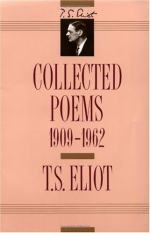|
This section contains 734 words (approx. 2 pages at 400 words per page) |

|
Point of View
While there are many third-person omniscient poems in the collection, the majority of the poems are a first-person point of view. Eliot himself narrates very personal poems of his life in England and his thought processes about history and the culture in which he lived. When he does use a third person point of view, it's to give a broad overview of the actions of the characters that he places on his poetic stage. The first-person narratives give a sense to the reader of knowing the speaker intimately. This is definitely the case with Eliot's famous poem, "The Love Song of J. Alfred Prufrock." The reader can feel Prufrock pouring his heart out to them, as if he needs to exorcise the demons inside his soul after many years of keeping them at bay. This first-person point of view lends great power to the poems, personalizing...
|
This section contains 734 words (approx. 2 pages at 400 words per page) |

|




